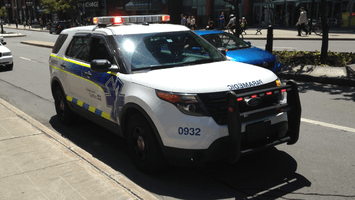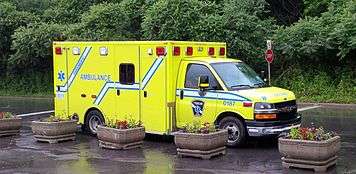Urgences-santé
Urgences-santé (English: Health Emergencies) is the statutory public emergency medical service for the islands of Montreal and Laval, Quebec. The corporation operates a fleet of 165 vehicles[1] and employs over 1,300 people, including 891 professional paramedics. Urgences-santé is one of the largest paramedical services in Canada.
 | |
| Established | 1989 |
|---|---|
| Headquarters | Montreal, Quebec |
| Jurisdiction | City |
| Total area (sq. miles) | 744 square kilometres (287 sq mi) |
| Employees | 1,300, including 891 paramedics |
| BLS or ALS | Both |
| Ambulances | 165 |
| Chief | Nicola D’Ulisse |
| Medical director | Dr. Gilles Bourgeois |
| Responses | 267, 666 (2017-2018) |
| Website | urgences-sante.qc.ca |
Organization
Urgences-santé as a corporation was formally created in 1989 under section 149.1 of the Loi sur les services de santé et les services sociaux and granted jurisdiction as a public health agency on the islands of Montréal and Laval,[2] where it is responsible for the planning, organization, coordination and evaluation of emergency medical services; the operation of an ambulance service, a first responder service, and a medical communications centre; providing management, training and expertise consultancy services to emergency medical service partners and maintaining the ability to commercialize such services in Québec, Canada and abroad.[2]
The corporation is the sole provider of advanced life support services in its jurisdiction, and a major provider of basic life support (BLS) alongside the Service de sécurité incendie de Montréal (the Montreal City Fire Department), the Département de sécurité incendie de Laval (Laval Fire Department), and various partners in the community, including Côte Saint-Luc Emergency Medical Services. Field operations are carried out by 891 full-time paramedics.
Operations
Urgences-santé is responsible for an area of over 744 square kilometres (287 sq mi) with a population of over 2.3 million people. It maintains a fleet of 165 ambulances and performs over 272,000 medical transports every year to, or between, 23 hospitals in the Montreal metropolitan region. Of the 363,000 emergency and non-emergency calls received in 2011, 285,000 required an ambulance dispatch, 226,000 required an ambulance transport, 70,000 required a priority 1 response for life-threatening situations, and 224 required a major emergency service mobilization. Operations are managed from three regional divisions: East, West and North.[3]
The ambulance service also maintains specialized units:
- Montreal Metro team that performs over 600 interventions a year in the metro
- Bicycle patrol team that performs over 450 sorties to cover summer festivals and events
- Technical support team that performs close to 3,000 interventions in support of paramedics
- Tactical team that is tasked with performing some 270 high-risk medical interventions alongside the Montreal and Laval SWAT teams.[3]


History
A citywide ambulance service was originally introduced by the Service de police de la Ville de Montréal in 1958. Many of the suburban municipalities followed Montréal's lead; island-wide service was provided when police services were centralized under the Montreal Urban Community in 1970. By the late 1970s, however, police ambulance training and equipment had fallen behind contemporary standards and the service was finally withdrawn. Urgences-santé was created in 1981 by forming a centralized dispatch system for the region's 25 privately owned ambulance services. The original full name was Centre de coordination des urgences santé (Health Emergencies Coordination Centre). As part of the program, a single telephone number for emergency medical services was introduced for the islands of Montreal and Laval (514-842-4242). All private services were invited to use Urgences-santé for dispatch and later, billing. The contracting companies were paid to maintain ambulance availability and on a per-call basis. Consolidation of the private companies and the formation of a militant labour organization caused much instability including a strike in 1986. In 1989, following the transfer of ambulance service to the health and social services department, the system was re-organized and formalized by an act of the Quebec National Assembly.
Advanced care paramedics
Historically staffed exclusively by primary care paramedics, one cohort or advanced care paramedics was trained in the late 1980s.
In 2016, a new 2-year advanced care paramedicine program was launched at Université de Montréal. The first cohort graduated in 2018.
References
- "Rapport annuel de gestion 2017-2018" (PDF). Urgences-santé. Gouvernement du Québec. Retrieved 16 May 2019.
- (in French) "Loi sur les services préhospitaliers d'urgences, section 87 (2002, c. 69, a. 87) and section 90 (2002, c. 69, a. 90; 2005, c. 32, a. 308". Canadian Legal Information Institute. Retrieved 21 January 2013.
- (in French) "Rapport annuel 2011-2012" (PDF). Urgences-santé. Retrieved 21 January 2013.
